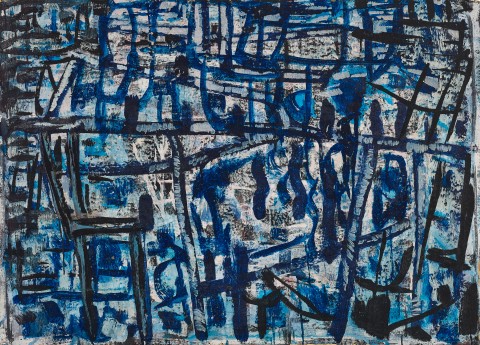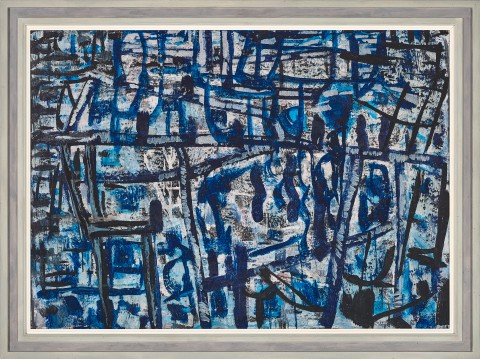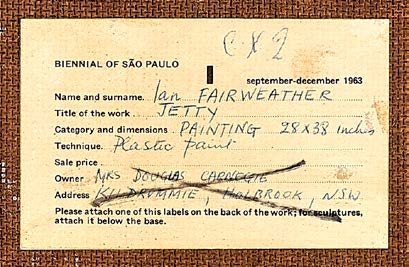Jetty, 1962
Ian Fairweather
synthetic polymer paint on cardboard on composition board
70.0 x 98.0 cm
bears inscription verso: "JETTY" / BY IAN FAIRWEATHER
bears inscription verso: JETTY / Res for Mrs D Carnegie
Perth Galleries, Western Australia
Margaret Carnegie, New South Wales, by 1963
Private collection
Sotheby's, Melbourne, 30 April 1995, lot 68
Private collection
Niagara Galleries, Melbourne (label attached verso)
Private collection, Melbourne, acquired from the above in March 2008
7th São Paulo Art Biennial, Ciccillo Matarazzo Pavilion, Ibirapuera Park, São Paulo, Brazil, 28 September - 22 December 1963, cat. 11 (label attached verso)
Blue Chip X: The Collectors' Exhibition, Niagara Galleries, Melbourne, 4 March - 5 April 2008, cat. 8
Bail, M., Fairweather, Murdoch Books, Sydney, 2009, p. 243
Roberts, C. & Thompson, J. (eds.), Ian Fairweather: A Life in Letters, Text Publishing, Melbourne, 2019, p. 326
1.jpg
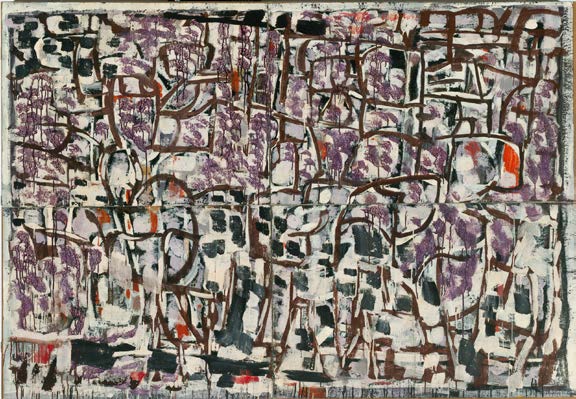
on composition board
In mid-1953 at the age of sixty-two, Ian Fairweather settled on Bribie Island, off the coast of Queensland, where he lived in a pair of self-built huts for the rest of his life. Despite the lack of creature comforts which most people take for granted, the relative contentment that Fairweather found in this environment was reflected in his artistic output which, over the following two decades, witnessed the production of many of his finest paintings. In 1962, a solo exhibition at the Macquarie Galleries in Sydney saw buyers camp out overnight in order to secure one of his recent works. The Sydney Morning Herald headline hailed Fairweather as ‘Our Greatest Painter’ and more than half of the sixteen paintings in the show were acquired for public collections, including Epiphany, 1961 – 62 (Queensland Art Gallery/Gallery of Modern Art); Mangrove, 1961 – 62 (Art Gallery of South Australia); and Shalimar, 1961 – 62 (National Gallery of Australia) which was purchased for the then-developing national collection. Among the determined collectors who waited outside the gallery in driving rain was the art critic, Robert Hughes, who bought Monsoon, 1961 – 62 – later acquired by the Art Gallery of Western Australia – describing it as ‘a pure example of ecstatic motion.’1
The critical and commercial success of this exhibition built on the momentum that had been growing for some years, and the ensuing decade saw Fairweather’s art acknowledged in significant ways. Although he was geographically isolated from the contemporary artworld, his work was well known – primarily through commercial exhibitions at Macquarie Galleries, as well as occasional visitors to the island – and highly regarded by critics, collectors and curators alike. During these years his paintings were included in the landmark exhibition Recent Australian Painting, curated by Bryan Robertson at the Whitechapel Gallery, London (1961); the European tour of Australian Painting Today (1964 – 65); and in 1965, a major travelling retrospective of his work was mounted by the Queensland Art Gallery.
2.jpg
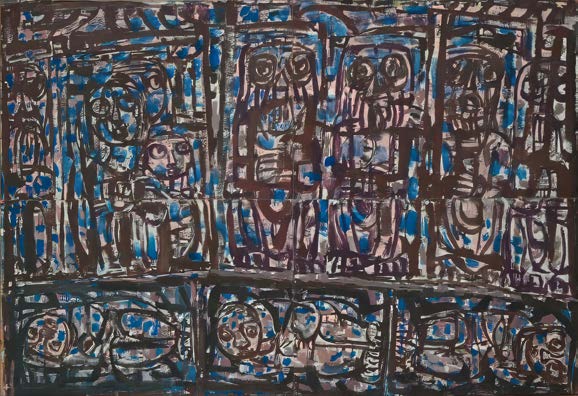
on composition board
In 1963, Fairweather was one of seven artists including John Perceval, Albert Tucker and Leonard Hessing selected to represent Australia at the VII Bienal de São Paulo. Although he was more than twenty years older than all his fellow Australian exhibitors – and the only one who was born in the nineteenth century – his work was utterly contemporary and very at home in such company. He showed four paintings: Shalimar, Portrait of the Artist, 1961 – 62 (National Gallery of Australia); Night Life, 1962 (private collection); and this work, Jetty, 1962 which was lent from the collection of Douglas and Margaret Carnegie.2 This selection reflected the tension that exists between representation and abstraction in Fairweather’s art. While the portrait and Night Life clearly reveal their figurative subjects, Shalimar, composed of at least seventy layers of paint, appears completely abstract.3 At first glance, Jetty also seems like an all-over composition of brushstrokes in vivid shades of blue, applied on top of a lively ground of linear and painterly marks. The title of the work provides a clue of course and closer inspection reveals that the sequence of black lines in fact describes a simple jetty, its support structure depicted in the lower left of the picture and its long narrow form roughly dividing the composition in half. Like much of Fairweather’s art, Jetty emphasises the act of painting and the physicality of his expressive style. It also reflects the notion proposed by Murray Bail that Fairweather ‘articulated mood’4, here, artfully conjuring up the sight, sound, smell and calming effect of water rhythmically lapping against a wooden jetty.
As Fairweather explained in 1962, ‘I started as a traditional painter, but I was always interested in abstract, and for a long time I worked on abstract lines. But I’ve decided that pure abstract doesn’t suit me, and I’m trying to get back in my work to some representation… To me, painting is a personal thing. It gives me the same kind of satisfaction that religion, I imagine, gives to some people.’5
1. Bail, M., Fairweather, Murdoch Books, Millers Point, 2009, p. 176
2. The Carnegies also lent a painting by Perceval to the 1963 São Paulo Biennial.
3. Bail, op. cit., p. 178
4. ibid., p. 161
5. Ian Fairweather, Interview with Murray Bail, op. cit., p. 268
KIRSTY GRANT
